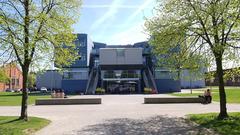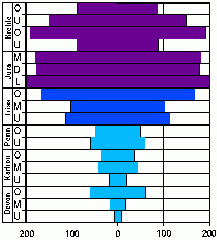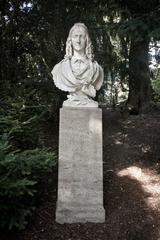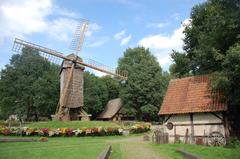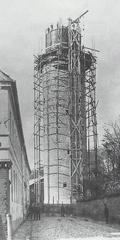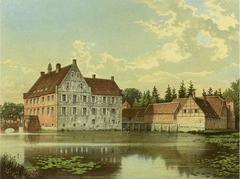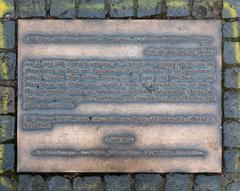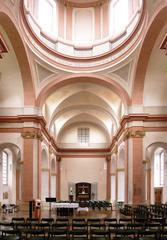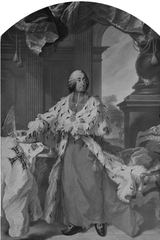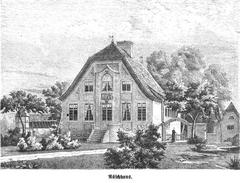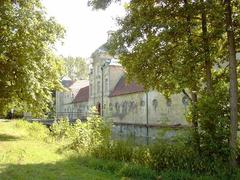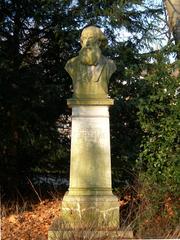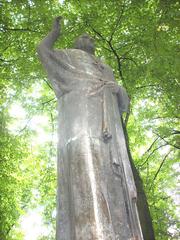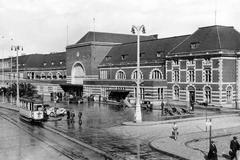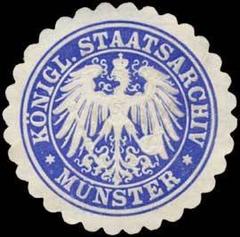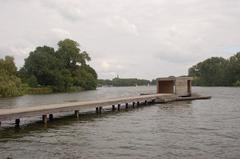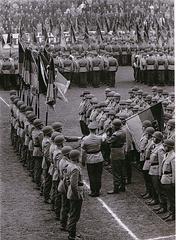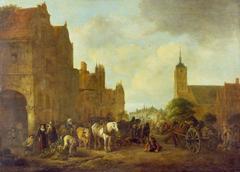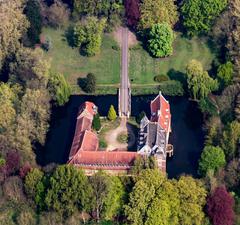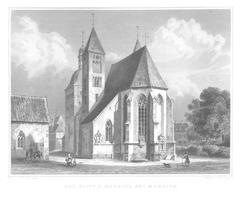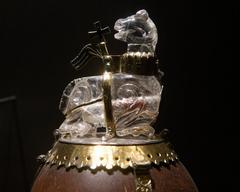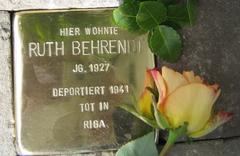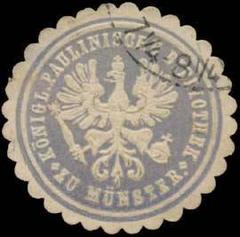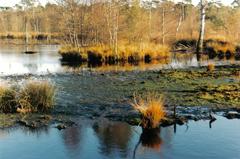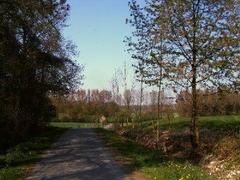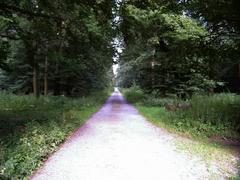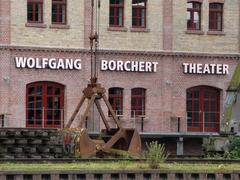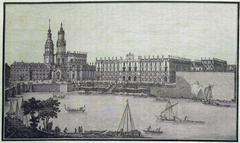
Collegium Borromaeum Münster: Visiting Hours, Tickets, and Historical Sites Guide
Date: 04/07/2025
Introduction
Located in the heart of Münster, Germany, the Collegium Borromaeum stands as a venerable institution representing centuries of Catholic tradition, theological education, and architectural heritage. Founded in the mid-19th century and named after St. Charles Borromeo—a key figure in the Catholic Reformation—the Collegium has played a pivotal role in shaping the spiritual and cultural character of Münster (Wikipedia).
This guide offers essential information for visitors, including practical details on visiting hours, ticketing, accessibility, and travel tips, while exploring the seminary’s architectural highlights, historical milestones, and significance within Münster’s broader religious and cultural landscape. Whether you are a history enthusiast, architecture lover, spiritual seeker, or cultural traveler, the Collegium Borromaeum promises an enriching experience (Europe for Visitors; Diocese of Münster).
Contents
- Historical Foundations and Religious Context
- Architectural Evolution and Artistic Highlights
- Educational Mission and Ecclesiastical Role
- Cultural Significance and Community Engagement
- Visiting Information: Hours, Tickets, Accessibility
- Travel Tips and Nearby Attractions
- Frequently Asked Questions (FAQ)
- Plan Your Visit and Explore More
Historical Foundations and Religious Context
The Collegium Borromaeum traces its roots to the Catholic Church’s efforts during the Counter-Reformation to strengthen clerical education. Founded officially in 1854, it was established to respond to the challenges posed by Protestantism and to implement the reforms of the Council of Trent, which emphasized rigorous priestly formation (Wikipedia).
Münster itself has a deep ecclesiastical heritage dating back to the 8th century and has long been a regional center of Catholicism. The seminary’s founding and continued existence reflect Münster’s identity as a Catholic stronghold and its ongoing commitment to faith-based education.
Architectural Evolution and Artistic Highlights
The Collegium Borromaeum’s current building was constructed between 1913 and 1915, blending historicist and modern architectural elements under the guidance of architects Holtmann, Taxin, and Broker (PDF: Karl-Leisner.de). The seminary’s façade features a relief of Maria Immaculata with Christ, symbolizing its mission of blessing and spiritual formation.
Inside, the chapel—rebuilt after wartime destruction—offers a tranquil space for prayer, marked by whitewashed walls and a focus on simplicity and contemplation. Notable artworks include the “Trauernde Theologie” sculpture by Emil Stadelhofer, memorializing seminarians lost in World War I, and a 1956 fresco by Richard Seewald depicting the Returning Christ (Visit Freiburg).
The building’s post-war reconstruction is a testament to Münster’s resilience and its dedication to preserving spiritual and architectural heritage (Europe for Visitors).
Educational Mission and Ecclesiastical Role
The Collegium Borromaeum serves as the principal seminary for the Diocese of Münster, as well as for Essen and Osnabrück (Wikipedia). Its programs integrate theological studies at the University of Münster with spiritual, pastoral, and personal development, guided by experienced faculty and spiritual advisors (Bistum Münster; Priesterseminar Münster).
The seminary has adapted to changing times by introducing initiatives such as the “Orientierungsjahr” (Year of Orientation) for young adults exploring faith and community, and by opening its doors to students from diverse academic backgrounds—including the admission of women since 2021/22 and refugees since 2015 (Borromaeum Sommerakademie; IDP Münster).
Since 2025, the site also hosts the Institut für Diakonat und pastorale Dienste (IDP), specializing in training for pastoral assistants and permanent deacons.
Cultural Significance and Community Engagement
The Collegium Borromaeum is not only an educational institution but also a hub for cultural and community life. It organizes summer academies, theological workshops, retreats, and public lectures, fostering dialogue between faith, culture, and contemporary society.
Special events, such as open days, liturgical celebrations, and concerts, invite the broader public to engage with the seminary’s spiritual and cultural heritage. Alumni and faculty participate actively in local parishes, charitable projects, and interfaith initiatives, strengthening the seminary’s connection with the wider Münster community (Borromaeum Sommerakademie).
Visiting Information: Hours, Tickets, and Accessibility
Visiting Hours
- General Access: The Collegium Borromaeum primarily functions as a residential and educational institution. Public access is limited to special events, open days (e.g., “Tag des offenen Denkmals”), and guided tours.
- Typical Open Hours for Visitors: Weekdays from 9:00 AM to 5:00 PM during special events. The Seminary Church is often open Tuesday to Sunday, 10:00 AM–5:00 PM. Always check official sources for updates (IDP Münster; Diocese of Münster).
Tickets and Admission
- Entry: Free of charge for open days, public events, and most guided tours. Donations are appreciated to support the seminary’s activities.
- Guided Tours: Offered periodically—advance registration is recommended, especially for groups or during heritage events. Guided city tours that include the Collegium can be booked via local providers (Münster Marketing - Guided City Tours).
Accessibility
- Wheelchair Access: The site is generally accessible, with ramps and elevators. For specific needs or to confirm arrangements, contact the administration in advance.
- Visitor Etiquette: Modest attire is recommended. Silence should be observed in the chapel and communal areas. Photography may be restricted in certain sacred spaces.
Travel Tips and Nearby Attractions
Getting There
- Address: Domplatz 8 (main building), Frauenstraße 3–6, 48143 Münster.
- Public Transport: Easily accessible from Münster’s main train station by bus, tram, or on foot.
- Parking: Limited parking is available nearby; public garages are the best option for drivers.
Attractions Within Walking Distance
- Münster Cathedral (St.-Paulus-Dom): A historic landmark with impressive Romanesque and Gothic architecture (The Crazy Tourist).
- Prinzipalmarkt: The city’s iconic arcaded marketplace, ideal for shopping and photography.
- Old Town: Rebuilt after WWII, offering charming streets and historic ambiance.
- LWL Museum of Art and Culture: Showcasing art from the Middle Ages to the present (LWL Museum of Art and Culture).
- Peace of Westphalia Sites: Explore locations linked to the treaties that ended the Thirty Years’ War.
Photography Highlights
Capture the building’s neo-Gothic façade, the serene chapel interior, and the picturesque courtyard. Please respect privacy and event-specific guidelines for photography.
Frequently Asked Questions (FAQ)
Q: What are the Collegium Borromaeum Münster visiting hours?
A: The seminary is generally open to visitors during special events and open days; the church is often accessible Tuesday to Sunday, 10:00 AM–5:00 PM. Confirm hours via the official website.
Q: Is there an entrance fee?
A: Admission is free; donations are welcomed.
Q: Are guided tours available?
A: Yes, during special events and through city tour providers. Advance booking is required for groups.
Q: Is the site accessible for people with disabilities?
A: Yes, there are ramps and elevators. Contact the administration for specific needs.
Q: Can I take photographs inside?
A: Photography is generally allowed outdoors; inside, follow posted guidelines and respect restrictions in sacred spaces.
Q: What are some nearby Münster historical sites?
A: Münster Cathedral, Prinzipalmarkt, and the Westphalian State Museum are all close by.
Plan Your Visit and Explore More
The Collegium Borromaeum Münster offers a unique glimpse into the city’s religious heritage, architectural elegance, and cultural life. With its rich history and ongoing community engagement, it stands as a testament to Münster’s enduring Catholic tradition.
For the latest information on visiting hours, ticketing, and events, check the official Diocese of Münster website, IDP Münster, and Münster’s tourism platforms.
To enhance your visit, download the Audiala app for guided tours and exclusive content about Münster’s historical sites. Follow us on social media for updates, travel tips, and news about upcoming events. Plan your journey to discover the Collegium Borromaeum and the many treasures of Münster’s vibrant heritage.
Further Reading and Official Sources
- Europe for Visitors: Collegium Borromaeum Münster Overview
- Visit Freiburg: Konviktskirche Seminary Church
- Wikipedia: Collegium Borromaeum Münster
- Karl-Leisner.de: Collegium Borromaeum Historical Document (PDF)
- Bistum Münster: Borromaeum Seminary Information
- Priesterseminar Münster: Seminary Programs
- IDP Münster: Institut für Diakonat und pastorale Dienste
- Borromaeum Sommerakademie: Summer Academy
- The Crazy Tourist: Best Things to Do in Münster
- Münster Cathedral Guide
- LWL Museum of Art and Culture
- Münster Marketing - Guided City Tours
- Events and Culture in Münster

